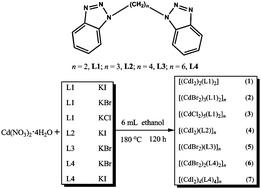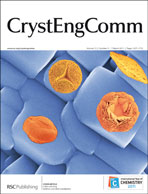Seven organic-inorganic hybrid solids, namely, [(CdI2)2(L1)2] (1), [(CdBr2)3(L1)2]n (2), [(CdCl2)5(L1)2]n (3), [(CdI2)(L2)]n (4), [(CdBr2)(L3)]n (5), [(CdBr2)2(L4)2]n (6), and [(CdI2)4(L4)4]n (7), have been obtained via the self-assembly of CdX2 (X = Cl, Br or I) with the four structurally related flexible organic ligands 1,2-bis(benzotriazole)ethane (L1), 1,3-bis(benzotriazole)propane (L2), 1,4-bis(benzotriazole)butane (L3) and 1,6-bis(benzotriazole)hexane (L4) under solvothermal conditions. Compound 1 presents a binuclear structure with a [Cd2N12C4] 18-membered cycle. In 2, the L1 ligands locate alternately on the two sides of the 1-D inorganic chain formed by papilionaceous [Cd2Br2] subunits. The 1-D hexagonal [CdCl2]n grid inorganic chains in 3 are generated by vertex-loss cubane-like [Cd3Cl4] motifs through sharing faces, which are further connected by L1 ligands to give a 2-D hybrid layer. For compound 4, the L2 ligands and 4-connected Cd centres link each other to give a 1-D single chain. In 5 and 6, [Cd2Br4] units are connected by L3 and L4 to generate a 2-D (4, 4) net and 1-D double chain structure, respectively. Four independent [CdI2] centres and four L4 ligands in 7 generate an extraordinarily large [Cd4N24C24] 52-membered cycle. The varying structures of 1–7 indicate that the spacer length of the bis(benzotriazole)alkane ligands and counter-anions play an essential role in the formation of the framework of the Cd(II) hybrid materials. Strong π–π stacking interactions between the benzotriazole ligands pack these low-dimensional hybrid chains or layers into high-dimensional supramolecular frameworks. The UV-vis diffuse reflectance spectra and solid state luminescence measurements show that compounds 1–7 are potential semiconductor and photoluminescence materials.


 Please wait while we load your content...
Please wait while we load your content...